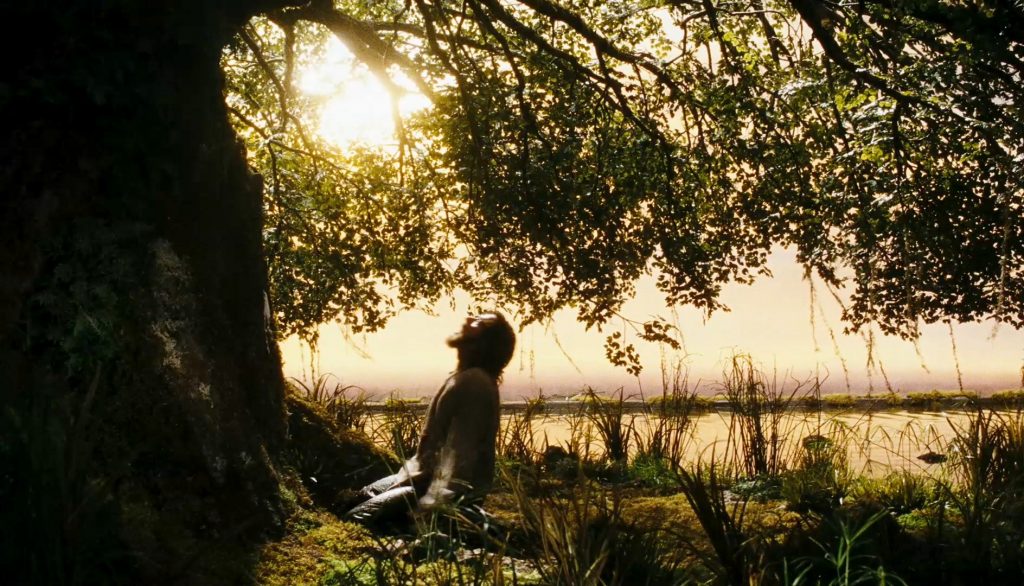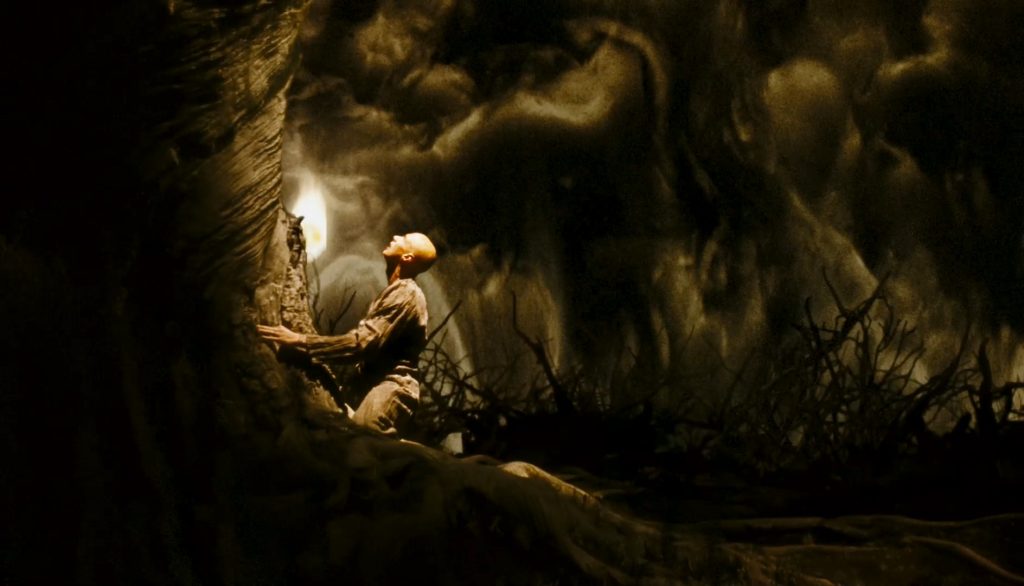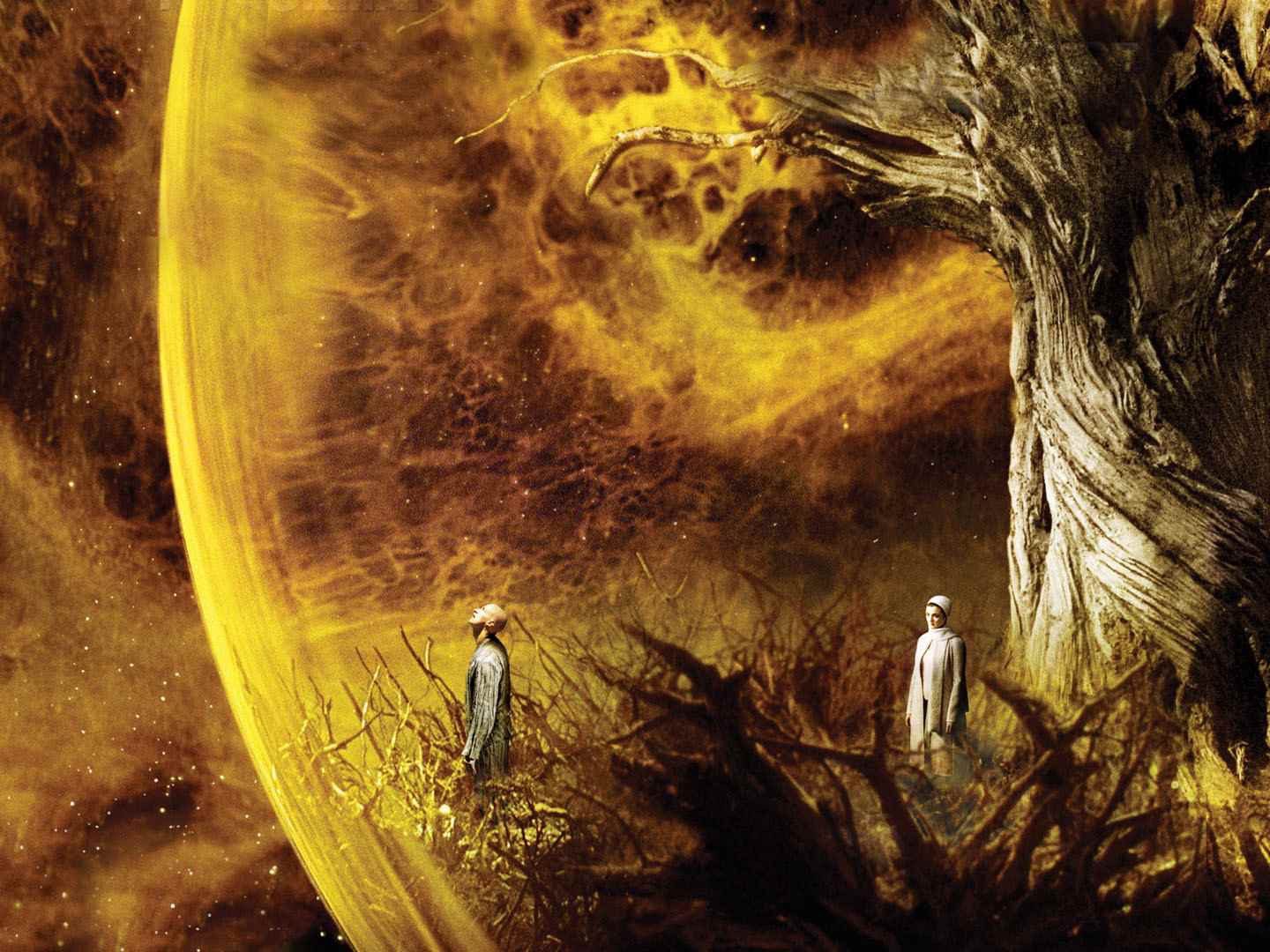This article is the first of a two-part series. The second part, which focuses on the Mayan creation story and religious themes, will be released shortly.
The Fountain is a movie written by Darren Aronofsky and released in theaters in 2006. It is the story of a man through the ages to save the woman he loves. The film, which belongs to the fantastic, dramatic, and spiritual genres, poetically weaves and romanticizes a man’s quest for death, and establishes the love union as a salutary principle. In such a fight, two principles are opposing: the hold of death, slaying a man through time, and the victory over such a finitude, carrying a promise of immortality. The film contains several themes; however, death and love are the overarching narratives. Those themes have been pushed to their limits in artistic fields, as they reflect timeless anxieties and metaphysical questions of each one, since the dawn of time.
The Fountain establishes in parallel the story of three characters, all played by the same actor: Tomás Verde, Spanish conquistador during the Inquisition in Spain, Thomas Creo, neurosurgeon in the 21st century, and Tommy, a spiritual master in 2500. The Thomas of the 21st century, is losing his wife, Izzi, ravaged by a cancer. Izzi is writing a manuscript, The Fountain, narrating the adventures of Isabella, Queen of Spain, and those of her fiancé, the conquistador Tomás Verde, in search of the Tree of Life, which would confer immortality to his queen and their love. The manuscript, which is a true metaphor that describes Izzi’s journey through death, is also the mirror of Thomas’s anguish. Her story is a true catharsis allowing her to help her husband to understand the steps that pave such a journey; in doing so, it transmutes the fear of death, leading her to accept her own destiny. In the 26th century, Tommy travels in space towards Xibalbá, in a bubble with the Tree of Life, perhaps the one that Thomas Creo planted on the grave of his wife five centuries ago. The Tommy of the future is also a man looking for immortality, convinced that he will be able to be reunited with his love.
This quest is a real work of patience, fully assimilated to that of Thomas Creo to save the woman he loves. The three stories, which do not unfold chronologically, are narrated in a non-linear way, seemingly separated by 5 centuries, and intertwined by numerous matching cuts, thus creating a sense of continuity between the three epochs. The proliferation of visual motifs, such as the ring that each of the three protagonists carry, link three periods, thus unifying the quest of the three characters. The poetry that surrounds the film captures the audience, which tries to decipher the meaning of the work and its mysteries.
The religious references are ubiquitous, and if they are mostly Judeo-Christian ones, they also embed elements of Shamanism, Mayan symbolism, and “spiritual” themes in the broad sense. Aronofsky seems to have anchored the film around two creation stories, that of Genesis and the Popol Vuh, the Mayan creation myth, while, at the same time, broadening the interpretative field, thus allowing a new reading on old but timeless themes. It is a complex work that does not fail to reveal a set of interpretations, that several readings unravel. Aronofsky explains to us that, despite the plurality of interpretations, the main message remains that of the acceptance of death, which then becomes a movement from darkness to light, and from destruction to recreation1.
I propose in this article an analysis around the three themes that I have identified, and which hold my interest: 1- Trials in the face of death, 2 – Rebirth or liberation, and 3 – Love and immortality2. As we will see, it is possible to tie these three movements to not only an arrangement that one would call “classical” in films (1: anchoring of the narration at the beginning, 2: apotheosis in the middle, and 3: conclusion at the end), but also to the sequence of the rite of passage, which I have discussed at great length in my other writings.
By applying the plot of initiatory schemes to the movie, the first sequence is that of detachment, which is literally a break with the profane world, as death threatens to fall on both the kingdom of Spain and on Izzi. The second movement is similar to the liminal phase, during which one acquires a new gnosis. In The Fountain, this gnosis leads to the liberation of the three men. Lastly, the last movement – immortality – is a symbolic transcendence of the profane condition that dominates the first phase. Such sequencing allows us to articulate the work around an initiation for the three protagonists evolving through three phases, all required for a salutary and final rebirth. I will then discuss the Popol Vuh, the Mayan creation myth in the second part, which I will use a basis for comparing the creation story that we witness in the movie. This will allow me to draw the similarities between this creation myth, but also the ways in which Daren Aronofsky has recycled a set of archaic themes in a contemporary fashion.
Let’s discuss the first theme, that of trials in the face of death. This first theme is announced in Spain, in the 16th century. The conquistador Tomás Verde is on a quest in search of the Tree of Life, in order to save Isabella of Castile, queen of Castile and Leon during the Inquisition3. In the movie, Isabella anticipates a bloody reconversion of her kingdom by the instigators. As an answer to the many cruelties threatening the kingdom, her fiancé Tomás appears as the only hope. In doing so, the hero faces many difficulties that threaten him every moment: in the jungle, he risks his life when he faces the Mayan soldiers, and the kingdom is itself threatened with “dying” if Tomás does not manage to find the sacred Tree of Life. During the encounter with the Mayan priest, the latter announces that “First Father sacrificed himself for the tree of life. Enter and join his fate”. When Tomás is stabbed by the priest, he let him know that “Death is the road to awe”4. Another scene presents the Inquisitor, who, while setting his plan to conquer the Spanish territories, explains that:
Our bodies are prisons for our souls. Our skin and blood, […] Death turns all to ash, and, thus, death frees every soul.
As for the soldiers who travel with Tomás, they get lost in the jungle, hopeless, when one of them announces that “There is no hope for us here. There’s only death!” Finally, in one of the last scenes, the sacrificial death of Tomás paradoxically allows life to bloom (plants and flowers grow from the body, replaying the sacrifice of the First Father). The hero reenacts here the Mayan creation story creation, since Tomás literally gives birth to life.

Let’s revisit the story of the contemporary Thomas. In one scene, Izzi and Thomas gaze at the stars, and Izzi explains to Thomas that the golden star, Xibalbá5, is:
Actually a nebula wrapped around a dying star. That’s what makes it look gold […] The Mayans called it Xibalba. […] It was their underworld. The place the dead souls go to be reborn.
It is also during this same scene that Izzi announces the writing of her story: “It begins there. Ends there” (while pointing at Xibalbá). And when at the hospital, Izzi, who, in tears, expresses his desire to see Thomas finish the last chapter, their dialogue evolves as follows: “I don’t know how it ends.” “You do. You will” “Stop!”
Lastly, when Izzi gives her last breath, Thomas is desperate and dejected, drowning in denial of the love he just lost. It is in his rage and pain that he sees death as “a disease. It’s like any other. And there’s a cure. A cure. And I will find it.” It is an obsession that leaves no respite, and for which Thomas determination corners him into an apparent denial: “Stop ageing, stop dying. Stop dying, that’s our goal.”
In 2500, Tommy’s crux is the same. The death that threatens the tree is the enemy to conquer; wishing to save it, he whispers: “You’ll make it. I won’t let you die.” And when his former companion, Izzi, appears dead on her bed, he exhales “Please, leave me alone!”
Here, once more, we have the expression of an agony which animates a man lost in his pain, that of the realization of finitude and death, but above all, that of the nostalgia for a love too early gone, which is a true affliction. Thus, Thomas in the future solidifies and crystallizes the theme of death. The fight takes place between his desire to conquer death, and its manifestations, as if to remind him with a greater strength that it is not possible to defeat it fully. The hero consoles himself, plunged into a denial that paradoxically allows him to advance in his journey:
Through that last dark cloud is a dying star. And soon enough, Xibalba will die. And when it explodes, you will be reborn. You will bloom. And I will live.

When the tree of life slowly fades, it is with fear that Tommy expresses “Don’t die! Don’t die! Don’t die! Don’t die!”. Such an injunction exacerbates the desperation that haunts this man, unable to oppose to the power of death. It is a death that means many things, including the transient, fragile, and ephemeral existence. These numerous scenes allow the audience to attest to the emotional violence when death strikes, and its repercussions.
The second theme, that of rebirth or liberation, counterbalances the first act. Rebirth appears as a salutary endeavor through which suffering is evacuated. It constitutes a “second movement” – the first being the trials in the fact of death. In The Fountain, this liberation manifests itself on several levels; whether emotional, spiritual, or physical, it breaks links with suffering. It also testifies to the determination of a man through the ages, driven by his passions that nothing stops. Let us quote for example Tomás the conquistador who, before embarking on the battle says:
We are her salvation, and through her command we shall live forever.
As for the inquisitor, he condemns the flesh which he transcends through his own sacrifice: “Death turns all to ash, and, thus, death frees every soul.” Whereas the queen opens herself to hope “These times are dark, but every shadow, no matter how deep, is threatened by morning light.”
Those times highlight a liberation by the light. It can just as well indicate that death in itself is not an end, and that good always ends up triumphing. The Queen of Spain highlights the contrast between dark and shadow, day and night, sunrise and sunset. It also reinforces a certain optimism through the manifestation of an absolute triumph over evil (that is, death). If hope permutes, it remains constant. In one of the last scenes, the liberation by the sacrifice ennobles all the more this salutary hope: “Forgive me, First Father. I did not know it was you. We shall be immortal. Our blood shall feed the earth.” The acceptance of death opens to liberation and eternity. In the movie, Izzi accepts her own death and finds solace in the Mayan creation story6, which she presents at the museum:
Look. It explains their creation myth. You see, that’s First Father. He’s the very first human […] He sacrificed himself to make the world. The Tree of Life’s bursting out of his belly […] His body became the tree’s roots.
They spread and formed the Earth. His soul became the branches, rising up, forming the sky. All that remained was First Father’s head. His children hung it in the heavens, creating Xibalbá
Through this creation story, Izzi liberates herself, a true catharsis which dissolves her anxiety and ontological concerns: “When I fell, I was full. Held.” Acceptance of death is unambiguous at the end of the movie, when both Thomas and Tommy accept death as a necessity. Thomas embraces it when he manages to complete the work of his wife, while Tommy agrees to let go of Life, that is to say, becoming aware of the weight of death and accepting it fully. Thomas lays a seed on Izzi’s grave and looks up at the heavens. He thus frees himself from the grip that held him prisoner of the material world. It can be said that he symbolically completed his destiny, allowing him to unite with his wife.
Notice the parallel between the liberation of Spain and the acceptance of death:
Tommy: Please, please. I’m afraid.
Isabella: Will you deliver Spain from bondage?
Thomás: I don’t know. I’m trying. I don’t know how.
[…]
Izzi: I’m not afraid anymore, Tommy.
Tommy: I’m gonna die. (with a smile)
Thomas: I’m going to die.
Isabella: Together we will live forever.
This second theme shows how death is abolished when one accepts it, and that is the message which is at the very heart of the film. It can be said that it is paradoxically the acceptance of death that engenders immortality. Izzi undoubtedly had such epiphany through the creation story. She understood that her death is a rebirth and not an end in itself. Liberation relieves her of all her fears and allows her to transcend her mortal condition.
The last movement, that of love and immortality, is superimposed on the previous one. As we have seen, it is out of love that the protagonists rush toward a tireless quest. For the three characters, this quest is the access to immortality, embedded in a love that transcends time. The quest is also a soteriology that paradoxically subdues the finitude of Life. Aronofsky gives the movie a mystical allure but manages to use it as an ultimate way to represent the potential for the deepest of human expression. Tomás, out of love for the Queen of Spain, decides to go in search of the Tree of Life that will save the Kingdom of Spain and unite him with the Queen. Thomas, out of love for Izzi, embarks on an unrelenting quest to find the cure for cancer that plagues her. Finally, it is out of love that Tommy decides to travel in space, to Xibalbá. The quest of the protagonists is perceived on many levels, and there is no doubt that the movie is a love story above all. The quest for the three heroes is twofold: to conquer and transcend death, and to exist in an eternal unifying love. When the Queen of Spain confides her alliance to Tomás, she expresses her desire for a promise of union:
You shall wear it when you find Eden, and when you return, I shall be your Eve.
Together, we will live forever.
The ring is a powerful motif that is found in all three epochs, and it has a rich symbolism. He is a mirror of a passion which sublimates the desire for an eternal love, but also the experience of an eternal life. When Tomás manages to access the tree, the ecstasy animates him, and it is with impatience that he seizes the ring that the queen entrusted to him:
My queen. Now and forever. We shall be together.
Note the scene in which the old man is lying on his bed, wearing a wedding ring on his finger, and for which a panicked Thomas notices that he still has not found his own. It is also out of love that Izzi gives the feather quill as a gift to Thomas so he can finish Izzi’s manuscript. Izzi, who realizes the eternal character of such love, tries to comfort Thomas:
Thomas: I want you to be with me.
Izzi: I am with you. Look. I’ll always be with you. I promise.
The quill is as much of a salutary object, because it is through the work of writing that Thomas can free himself, like Izzi did. The Thomas of the present may have discovered his own immortality by losing his wife, thus remained alive for more than 500 years, and is trying to reach Xibalbá, where Izzi’s eternal soul lives. Tommy’s quest would be that of Thomas, driven by the desire to reunite with Izzi. Such passion blends with subtlety the desire for a transcendent love in time to inscribe itself in eternity. The film sensitively presents the intimate and ultimate bond that unites these two themes. And in doing so, it invites the audience to meditate on the profound meaning of universal themes that stand the test of time.
Footnotes
- Jessica Kiang, Darren Aronofsky Says ‘The Fountain’ Was Too Expensive, Talks Connecting ‘Noah’ With Modern Audiences & More. Indiwire.com, 2012.
- All the following quotes are the transcription of The Fountain, produced by Warner Bros Pictures, 2006.
- Readers will not fail to point out the anachronism: Queen Isabella and her husband, King Ferdinand, were the instigators during the Spanish Inquisition, which means that she wouldn’t have any relationship with a conquistador. Moreover, she wasn’t herself the target of the Inquisition.
- Awe is a term that is difficult to translate. It can mean “contemplation”, “fear”, as well as “reverence”. In this context, contemplation and reverence are the terms that seem most relevant to us.
- Xibalbá, which could be translated as “place of fear”, is the underworld in the K’iche’ mythology, on which the gods of death reign. The Mayan legends tell that the road that leads to it is dangerous and full of pitfalls. Demons reigning over this subterranean world are said to be responsible for human afflictions, among them death. For more information, see Paul John Wigowsky’s Maya Pilgrimage: Xibalbá, Maximon, and Our Galaxy. Authorhouse, 2010.
- Although the myth she narrates is somewhat different from the original version, as narrated in the Popol Vuh, it does present some similarities. More about differences and similarities in the second part.


Pingback: Daren Aronofsky’s The Fountain: An Analysis — part 2 - Mes Vicissitudes